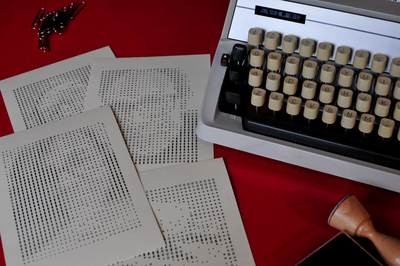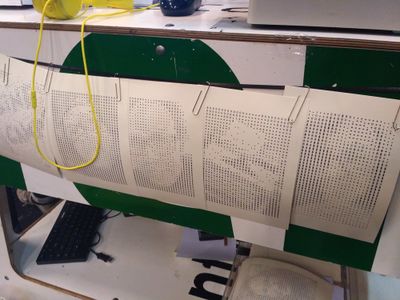Difference between revisions of "Text Images"
| Line 1: | Line 1: | ||
Text Images | Text Images | ||
==Dates== | |||
22Jan-2Feb. Tuesday - Friday. 13:00-16:00. | |||
Room | |||
==Description== | ==Description== | ||
| Line 8: | Line 14: | ||
[[File:excelfie-2017-11-12-18.28.12.jpg|Excelfie at Zinecamp 2017|400px|right]] | [[File:excelfie-2017-11-12-18.28.12.jpg|Excelfie at Zinecamp 2017|400px|right]] | ||
===Announcement text=== | ===Announcement text=== | ||
What are digital (bit-map) images? In their simpler form nothing more but sequence of pixels, each with its color value, organized into lines and rows. Such form of representing image information is uncannily similar to how text is represented digitally: a line-by-line sequence of characters, each with its corresponding value (code point). Can this similarity be used to transform pixel-based images into similar looking images made solely by text? And what happens when we reverse the process and try to get the text-based images into pixels using Optical Character Recognition software? | What are digital (bit-map) images? In their simpler form nothing more but sequence of pixels, each with its color value, organized into lines and rows. Such form of representing image information is uncannily similar to how text is represented digitally: a line-by-line sequence of characters, each with its corresponding value (code point). Can this similarity be used to transform pixel-based images into similar looking images made solely by text? And what happens when we reverse the process and try to get the text-based images into pixels using Optical Character Recognition software? | ||
==Material == | |||
We will work towards the implementation of the Excelfie in the Publication Station, for which we'll use: | |||
* raspberry Pi | |||
* camera (webcam) | |||
* LCD screen (HDMI input) | |||
* headphones | |||
* typewriter | |||
==Organization== | ==Organization== | ||
ASCII Art | ASCII Art | ||
* ASCII & Plain text | * ASCII & Plain text | ||
* ASCII | ** origins of ASCII encoding | ||
* Typewriter Art | ** previous encodings | ||
** current encoding: Unicode | |||
Typewriter Art | |||
** vitality of type writer art | |||
Bit maps: | |||
* sequences of pixels | |||
* color depth | |||
Plain-text image formats | |||
* bit maps: sequences of pixels | |||
Capturing images | |||
Assembling All Together | |||
------ | |||
=ASCII= | |||
==ASCII encoding== | |||
==ASCII Art== | |||
<blockquote> | |||
ASCII art is text art created with ASCII, a protocol established by the | |||
American National Standards Institute (ANSI), which is America's | |||
representative to the International Organization for Standardization | |||
(IOS). ASCII art uses ASCII text characters to produce images. The | |||
emoticon, an element of text messaging and email, is an example of ASCII | |||
art at its most popular and functional. </blockquote> | |||
<ref>‘ASCII ART’. n.d. Accessed 2 January 2018. http://artscene.textfiles.com/information/ascii-newmedia.txt</ref> | |||
<blockquote>Ascii Art as an idea coalesced into existence bceause people | |||
wanted more. They wanted more than just your standard Hercules | |||
display Atari or your Monochrome Commodore 64. To meet this | |||
demand, one singular artist, whose name is lost to the annals of | |||
history decided to take the plunge. Instead of text, he (or she) | |||
had the ingenuity to use the characters /, \, |, -, _ and | |||
whatever else came to mind to create words. An amazing idea. | |||
</blockquote> | |||
<ref> | |||
Necromancer. 1998. ‘History of the PC Ascii Scene’. March 1998. http://artscene.textfiles.com/history/essays/pcascii.txt</ref> | |||
=== ascii software === | |||
* figlet - display large characters made up of ordinary screen characters | |||
* cowsay - cowsay/cowthink - configurable speaking/thinking cow | |||
* jp2a - convert JPEG images to ASCII | |||
=Bit maps= | |||
==bit maps: sequences of pixels== | |||
== color depths== | |||
** 1-bit color (2 colors): monochrome, often black and white, | ** 1-bit color (2 colors): monochrome, often black and white, | ||
** 2-bit color (4 colors) | ** 2-bit color (4 colors) | ||
| Line 35: | Line 97: | ||
** 24-bit True color (16777216 colors): 256 shades of each color channel red, green, and blue | ** 24-bit True color (16777216 colors): 256 shades of each color channel red, green, and blue | ||
==plain-text image formats== | |||
** [https://en.wikipedia.org/wiki/X_PixMap#XPM3 X PixMap] (.xpm) | ** [https://en.wikipedia.org/wiki/X_PixMap#XPM3 X PixMap] (.xpm) | ||
** [https://en.wikipedia.org/wiki/Netpbm_format NetPBM] | ** [https://en.wikipedia.org/wiki/Netpbm_format NetPBM] | ||
| Line 41: | Line 103: | ||
*** Portable GrayMap[2] P2 P5 .pgm 0–255 (gray scale) | *** Portable GrayMap[2] P2 P5 .pgm 0–255 (gray scale) | ||
*** Portable PixMap[3] P3 P6 .ppm 0–255 (RGB) | *** Portable PixMap[3] P3 P6 .ppm 0–255 (RGB) | ||
== references == | |||
‘Ascii vs. Binary Files’. n.d. Accessed 2 January 2018. https://www.cs.umd.edu/class/sum2003/cmsc311/Notes/BitOp/asciiBin.html. | |||
Borzyskowski, George. n.d. ‘THE HACKER DEMO SCENE AND IT’S CULTURAL ARTIFACTS’. Accessed 2 January 2018. http://artscene.textfiles.com/history/essays/borzysko.txt. | |||
Bourke, Paul. n.d. ‘A Beginners Guide to Bitmaps’. Accessed 2 January 2018. http://paulbourke.net/dataformats/bitmaps/. | |||
‘Digital Art Guild - Portait of the Artist as a Young Scientist by Ken Knowlton’. n.d. Accessed 2 January 2018. http://www.digitalartguild.com/content/view/26/26/. | |||
Ippgi. n.d. ‘History of the Scene: The Beginnings of the IBM-PC Underground’. Accessed 2 January 2018. http://artscene.textfiles.com/information/history.html. | |||
Thomas, Matthew. n.d. ‘Welcome to Ascii-Art’. Accessed 2 January 2018. http://artscene.textfiles.com/information/faq-altasciiart.txt. | |||
Revision as of 14:41, 2 January 2018
Text Images
Dates
22Jan-2Feb. Tuesday - Friday. 13:00-16:00.
Room
Description
The following elective will be based on the project Excelfie by design Lucia Dossin, where selfie (images), captured by a digital camera are converted onto plain-text files (ASCII-art). In these text-based images, the sequence of pixels of the captured images is mapped onto corresponding text characters, in order to create text-based rendition of the original bit map image.
Announcement text
What are digital (bit-map) images? In their simpler form nothing more but sequence of pixels, each with its color value, organized into lines and rows. Such form of representing image information is uncannily similar to how text is represented digitally: a line-by-line sequence of characters, each with its corresponding value (code point). Can this similarity be used to transform pixel-based images into similar looking images made solely by text? And what happens when we reverse the process and try to get the text-based images into pixels using Optical Character Recognition software?
Material
We will work towards the implementation of the Excelfie in the Publication Station, for which we'll use:
- raspberry Pi
- camera (webcam)
- LCD screen (HDMI input)
- headphones
- typewriter
Organization
ASCII Art
- ASCII & Plain text
- origins of ASCII encoding
- previous encodings
- current encoding: Unicode
Typewriter Art
- vitality of type writer art
Bit maps:
- sequences of pixels
- color depth
Plain-text image formats
Capturing images
Assembling All Together
ASCII
ASCII encoding
ASCII Art
ASCII art is text art created with ASCII, a protocol established by the American National Standards Institute (ANSI), which is America's representative to the International Organization for Standardization (IOS). ASCII art uses ASCII text characters to produce images. The emoticon, an element of text messaging and email, is an example of ASCII
art at its most popular and functional.
Ascii Art as an idea coalesced into existence bceause people
wanted more. They wanted more than just your standard Hercules display Atari or your Monochrome Commodore 64. To meet this demand, one singular artist, whose name is lost to the annals of history decided to take the plunge. Instead of text, he (or she) had the ingenuity to use the characters /, \, |, -, _ and whatever else came to mind to create words. An amazing idea.
ascii software
- figlet - display large characters made up of ordinary screen characters
- cowsay - cowsay/cowthink - configurable speaking/thinking cow
- jp2a - convert JPEG images to ASCII
Bit maps
bit maps: sequences of pixels
color depths
- 1-bit color (2 colors): monochrome, often black and white,
- 2-bit color (4 colors)
- 3-bit color (8 colors)
- 4-bit color (16 colors)
- 5-bit color (32 colors)
- 6-bit color (64 colors)
- 8-bit color (256 colors)
- 8-bit greyscale (256 grey colors): each pixel represents only an amount of light (intensity information)
- 12-bit color (4096 colors):
- 24-bit True color (16777216 colors): 256 shades of each color channel red, green, and blue
plain-text image formats
references
‘Ascii vs. Binary Files’. n.d. Accessed 2 January 2018. https://www.cs.umd.edu/class/sum2003/cmsc311/Notes/BitOp/asciiBin.html.
Borzyskowski, George. n.d. ‘THE HACKER DEMO SCENE AND IT’S CULTURAL ARTIFACTS’. Accessed 2 January 2018. http://artscene.textfiles.com/history/essays/borzysko.txt.
Bourke, Paul. n.d. ‘A Beginners Guide to Bitmaps’. Accessed 2 January 2018. http://paulbourke.net/dataformats/bitmaps/.
‘Digital Art Guild - Portait of the Artist as a Young Scientist by Ken Knowlton’. n.d. Accessed 2 January 2018. http://www.digitalartguild.com/content/view/26/26/.
Ippgi. n.d. ‘History of the Scene: The Beginnings of the IBM-PC Underground’. Accessed 2 January 2018. http://artscene.textfiles.com/information/history.html.
Thomas, Matthew. n.d. ‘Welcome to Ascii-Art’. Accessed 2 January 2018. http://artscene.textfiles.com/information/faq-altasciiart.txt.
- ↑ ‘ASCII ART’. n.d. Accessed 2 January 2018. http://artscene.textfiles.com/information/ascii-newmedia.txt
- ↑ Necromancer. 1998. ‘History of the PC Ascii Scene’. March 1998. http://artscene.textfiles.com/history/essays/pcascii.txt

